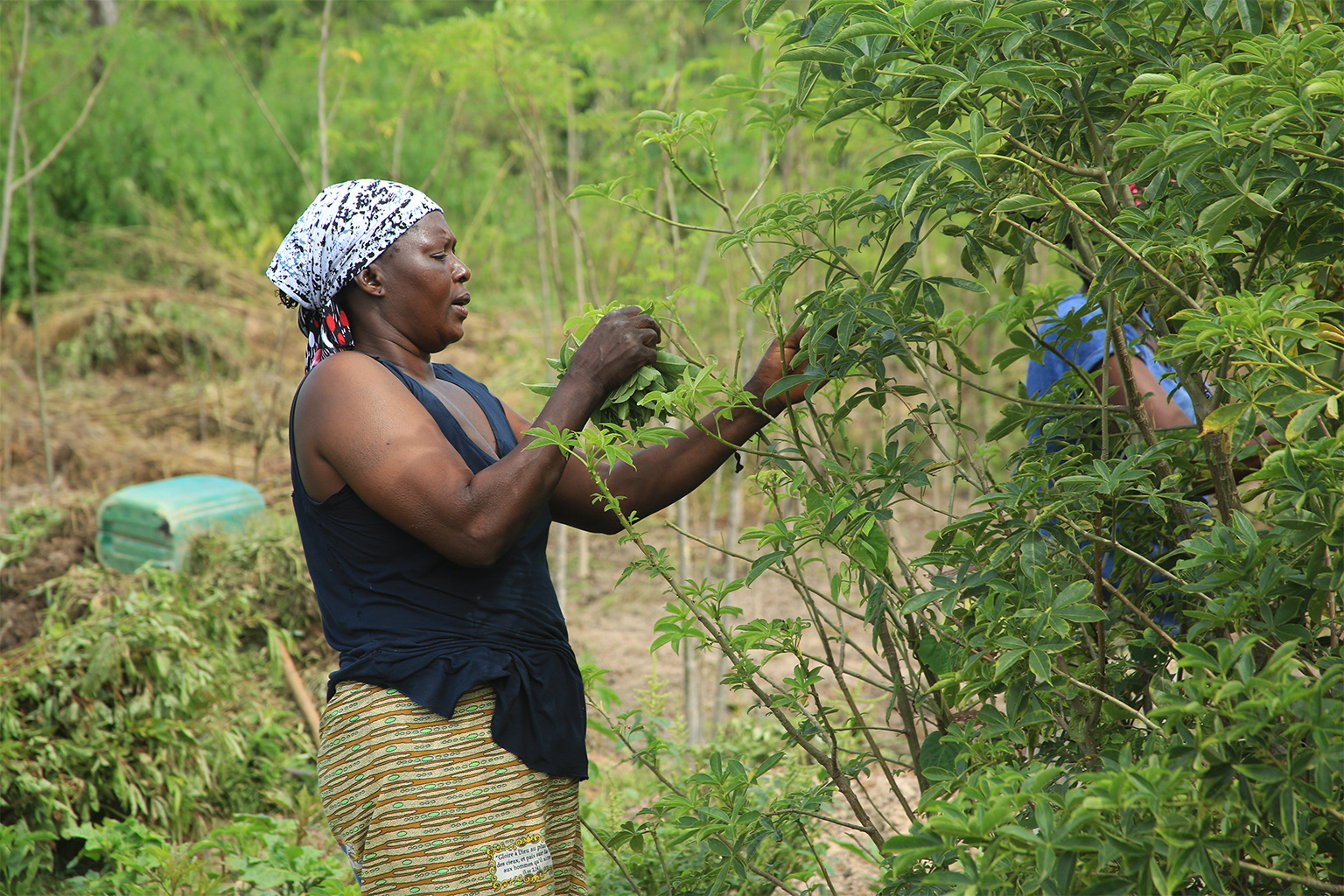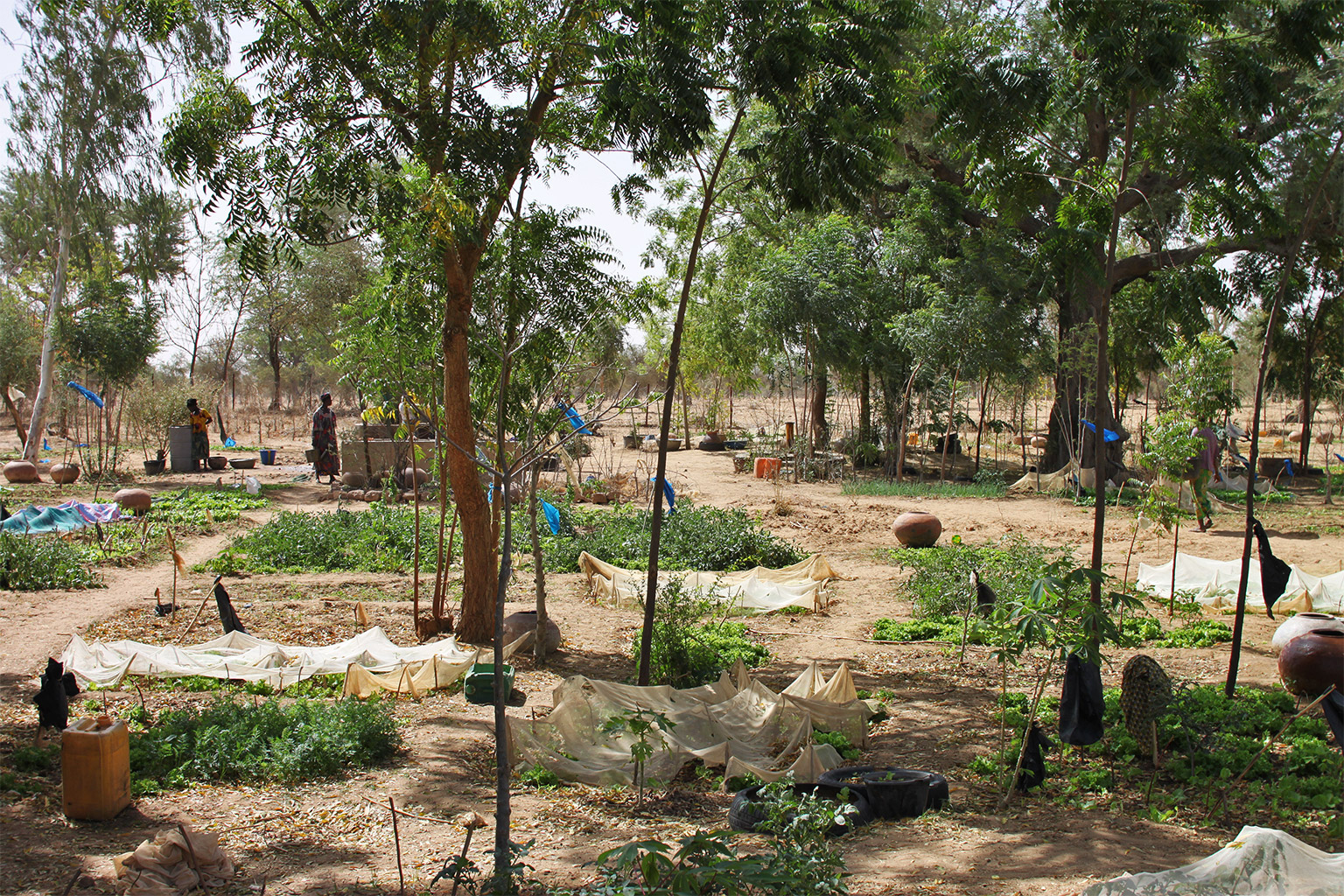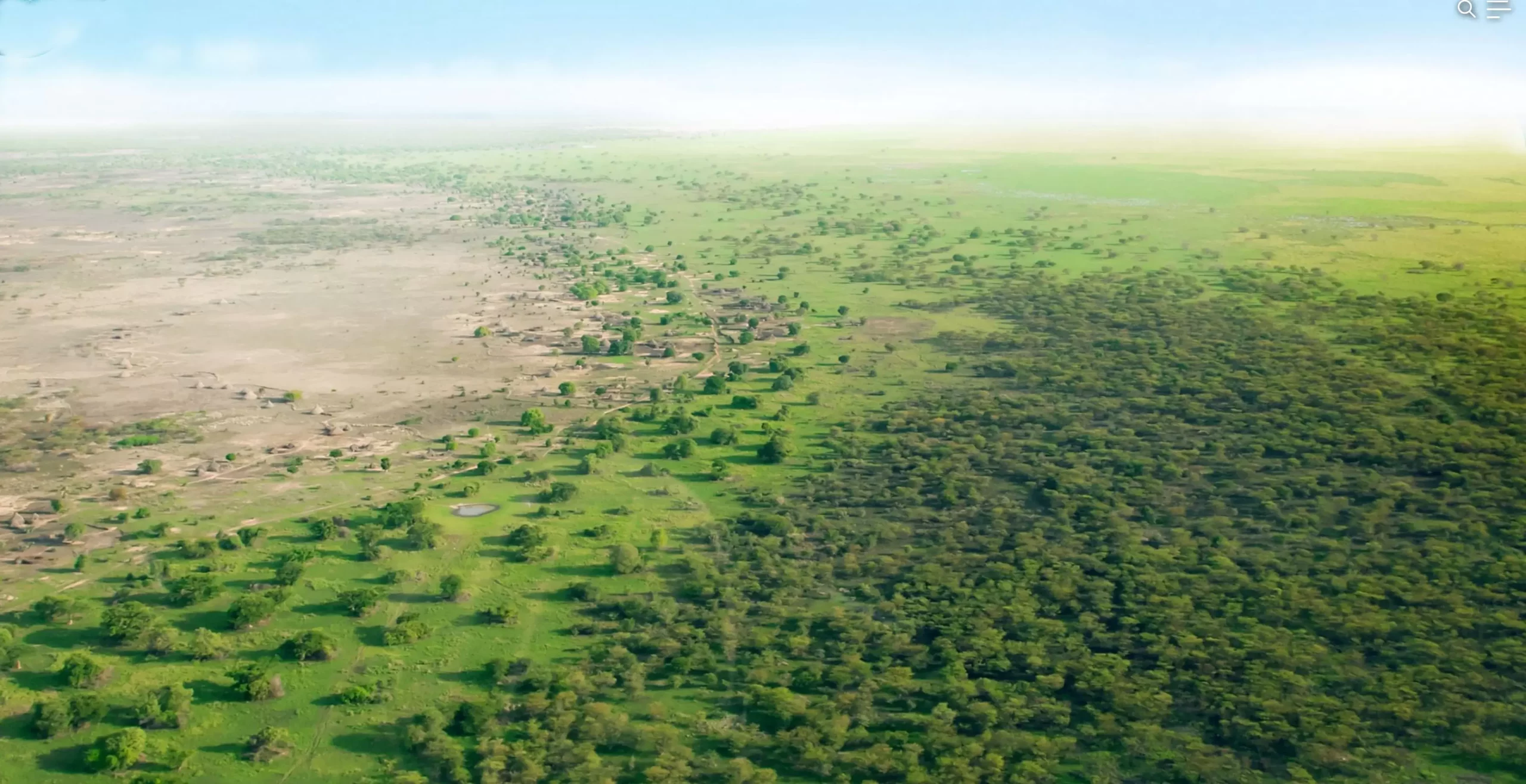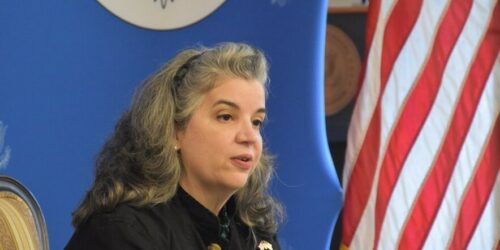The southern fringes of the Sahara are dynamic. As rainfall varies, land patches on the edge chop and change between green and arid brown. Human activities, like overgrazing, deforestation or poor irrigation, further degrade some of the already arid parts of the Sahel, resulting in desertification. As the planet heats up, changes in rainfall patterns can cause longer dry spells on the southern boundaries of the Sahara, stretching the desert further down, and affecting nearly a million people and their livelihoods in the Sahel.
In 2007, the African Union responded to the aridification of the Sahel by resolving to build a “Green Wall” running 8,000 kilometers (5,000 miles). The tree barrier, as it was initially conceptualized, would extend all the way from Dakar in the west to Djibouti in the east and be completed by 2030. The idea of the wall slowly morphed into a more flexible concept with a socioeconomic angle: a mosaic of forested land, interspersed with farmland and grassland, spread over 780 million hectares (1.93 billion acres), that also benefits local communities.
Officially known as the Great Green Wall for the Sahara and the Sahel Initiative (GGWSSI), this ambitious effort aims to restore 100 million hectares (247 million acres) of degraded land, sequester 250 million metric tons of carbon to combat climate change, and create 10 million jobs by the end of this decade. More than 20 African countries have partnered with several international agencies, research institutes, and civil society and grassroots organizations to build the wall and prevent the aridification of Sahel while also providing livelihoods and ecological benefits to more than 200 million people living across the affected region.
“The Great Green Wall Initiative is a flagship program,” Amadou Diallo tells Mongabay. “It aims to contribute to the eradication of poverty, to ensure growth and sustainable development through … participatory and integrated management of natural resources and the environment in the Sahara-Sahel region.”
Diallo is in charge of the environmental action plan for the African Union Development Agency’s New Partnership for Africa’s Development (AUDA-NEPAD), which coordinates the implementation of the Great Green Wall Initiative.
Despite its lofty goals, there’s been little progress in building the Great Green Wall. To date about 18 million hectares (44 million acres) of degraded land has been restored. Though this represents an area the size of Cambodia, it’s still only 18% of the total target. Securing the necessary $33 billion to fully fund the ambitious project has faced failed promises, painful delays and poor coordination between stakeholders and financial partners, pushing the initiative off its tracks. In 2021, French President Emmanuel Macron and other world leaders announced the Great Green Wall Accelerator, an initiative to turbocharge the building of the wall with a pledge of $14.3 billion in new funding for 2021-2025, which has helped it pick up pace. As of March 2023, $2.5 billion of that pledge has been disbursed.
“Over the last two or three years, there’s been a lot more interest in the subject than there had been,” says Tom Skirrow, CEO of Tree Aid, an NGO that works on land restoration and tackling poverty in the Sahel. “The UNCCD [United Nations Convention to Combat Desertification] is creating an accelerated team which is a little bit more focused on trying to help deliver [the Great Green Wall Initiative].”


Moving beyond tree planting
The idea of planting tree barriers or green walls to stop the spread of deserts has met with little success worldwide.
“A wall connotes a contiguous band of trees, growing at a regional scale, and nature doesn’t work that way,” says Matt Turner from the University of Wisconsin–Madison, who has studied the Sahelian ecosystems since 1987. He says the idea of an “expanding” desert is outdated, with recent scientific understanding favoring the view that desert boundaries are dynamic landscapes that change based on variations in rainfall — something that’s now being exacerbated by climate change.
Tree barriers, especially in arid regions, do little to address rainfall changes, and often don’t succeed in the long term. They may struggle to grow, or are eventually cut down for fuel, or may even displace local pastoral communities. When the Great Green Wall was first announced, the idea was to build such a tree barrier.
“The image of the Great Green Wall elicits donors and funding. That’s a powerful image,” Turner says. “We can’t discount that it’s wrong.”
Over years, faced with criticism about its effectiveness, the idea of a wall of trees morphed into a mosaic of landscapes that provide multiple benefits: preventing aridification, combating climate change, and supporting local livelihoods through agriculture, beekeeping, agroforestry and animal rearing.

Since 1987, Tree Aid has been working in the drylands of Senegal, Mali, Burkina Faso, Ghana, Niger and Ethiopia, all of which are involved in the Great Green Wall Initiative. The organization not only works on land restoration but also advocates for land governance and land management, which are crucial for generating sustainable income for local communities. It has nearly 100 staff in Africa and says it plants one tree every 19 seconds as part of the Great Green Wall Initiative. So far, it says its work has restored and protected more than 167,000 hectares (413,000 acres) of degraded land.
With carbon offsets emerging as a financing model for land restoration projects, Tree Aid has partnered with the International Olympic Committee (IOC) to grow an “Olympic forest” in Mali and Senegal. The project aims to grow more than 589,000 trees as part of the Great Green Wall, capable of sequestering 200,000 tons of CO2 equivalent over 25 years — more than the IOC’s estimated carbon footprint for 2021-2024. Skirrow says Tree Aid’s carbon-offsetting projects serve as another income stream for local communities, cutting out middlemen and profiteering, and helping long-term management of restored land. The organization also educates local communities about their rights and trains them with skills needed for restoration.
Experts say Senegal has so far been the most successful in its endeavor to build the Great Green Wall within its borders. AUDA-NEPAD’s Diallo, who is from Senegal, attributes this success to the bottom-up approach it follows in working with communities and designing a land governance model where land tenure belongs to the communities instead of the state.
“The ownership is there by the rural population, so they feel that this initiative belongs to them,” he says.
Skirrow adds: “Restoration isn’t the be all and end all of this. There’s long-term incentives to restoration — you have better land, better yields, generally better outcomes for you and your family — but the short-term incentives [are] particularly around income generation.”


Putting livelihoods at the core
Successful restoration and reforestation programs, which are at the core of the Great Green Wall Initiative, require tree species that can survive and thrive in the arid fringes of the Sahel while also benefiting local communities through food, medicine or income.
“You need to select the right species to plant them in the right place,” says botanist Tiziana Ulian from Royal Botanic Gardens, Kew, in the U.K., the scientific partner for the Great Green Wall Initiative.
Ulian also led a Great Green Wall cross-border pilot project in Burkina Faso, Mali and Niger from 2013-2020, under Kew’s Millennium Seed Bank Partnership, to build a restoration model that could help the environment and the local communities.
“Through this pilot, we try to develop a model to be used for the wider initiative,” she says.
Partnering with the U.N. Food and Agriculture Organization’s Forestry Department and national forestry organizations in the three countries, Ulian’s team worked with local communities in 120 villages to identify useful, native plant species to be used in restoration efforts. “Our focus has been on native species because they’re more likely to withstand climatic change [and] they have a wider genetic diversity,” she says.
The team identified 55 woody and herbaceous species that fit the bill, including baobab (Adansonia digitata) whose fruits are rich in vitamin C; the oil-producing balanite (Balanites aegyptiaca) and African crabwood (Carapa procera); gum acacia (Senegalia senegal) that produces the commercially valuable gum arabic; tamarind (Tamarindus indica), used as food; and African grape (Lannea microcarpa), used as medicine. As part of the pilot, restorers planted 2,235 hectares (5,523 acres) of degraded land with these trees, creating opportunities for sustainable income for 32,000 people.
The seeds, collected from the wild, were also added to the seed bank, aiding to the conservation of these species. “What we did through the Great Green Wall [pilot project] is combining conservation with sustainable development and restoration,” Ulian says.
Helping local communities generate income can also mean that restored areas are protected in the long term. “If you plant a tree without economic value, people will just cut it to make charcoal in a couple of months,” Diallo says. “But if they know that [it] produces moringa powder that can bring some revenue, they will keep it like God.” This powder, from the pulverized leaves of the moringa tree (Moringa oleifera), is a source of many vitamins.


Tackling challenges
While securing funding remains a major challenge, there are other barriers. The precarious security situation in the region is at the top of the mind for most experts. “There are many terrorist groups that are operating in the corridor of the Great Green Wall,” Diallo says, citing the examples of Boko Haram and Ansar Dine. While some restoration organizations have focused on working in safer areas, local people, scared for their safety and burdened by chronic poverty, risk their lives in search of greener pastures.
“Many people cross the Sahara Desert and even die in the Mediterranean Sea” to seek a safer and better life, Diallo says.
Growing trees in the arid and semi-arid regions of the Sahel, where water is scarce, is a huge challenge. While native plants are adapted to the local conditions, water is still a necessity for successful restoration. To harvest rainwater, some communities along the Great Green Wall dig up trenches, called retention basins, to store rainwater and make it last for about two to three months after the rains. In some areas, underground wells provide precious water.
Turner, who served on the team that evaluated the Great Green Wall project in 2021, found there was very little monitoring and record keeping of different reforestation projects that were underway as part of the initiative. “It took a fair amount of fieldwork actually,” he says of his experience in Niger. “There’s so little records of not only success or failure, or [social or ecological] impact, but there’s not even record keeping about where the projects have occurred.” As a result, long-term monitoring becomes a challenge.

Other challenges abound: the ongoing insurgency in Sudan is threatening progress in some regions; desert locusts, which arrive in swamps and can devour the lush green vegetation in the restored landscapes overnight, are also a concern for organizations and local people.
Coordinating the ambitious project and bringing all partners up to speed has been a logistical nightmare for AUDA-NEPAD, given that it’s working with more than 20 countries and numerous international organizations and funding partners, “Some countries haven’t set up a national agency for the Great Green Wall, and we have to mobilize them to see the benefits,” Diallo says.
Lack of coordination also hampers the work of NGOs like Tree Aid, when there’s lack of clarity on the roles and responsibilities of various stakeholders. “When people talk about the mosaic program of how the Great Green Wall should look, I think they have to think about the mosaic of actors,” Skirrow says, adding that the aim of facilitating agencies is to make things easier for stakeholders to do their work. “At the moment, I don’t think we’re doing that because we still conceive of this as a singular project with a singular kind of management plan.”
From a scientific standpoint, collaboration and sharing knowledge is crucial for the success of the Great Green Wall, Ulian says. “As a scientist, you can help select the species, but if you don’t work together with government organizations, nongovernmental organizations, the international community, your impact is very limited.”
With the recent funding promises as part of the accelerator, there are bright spots for Africa’s proud initiative. As Skirrow puts it: “I think we have to see it much more as a movement and a movement that we can ignite if we put the right funding in the right places and the right efforts and in the right places.”
Source: Monagabay






